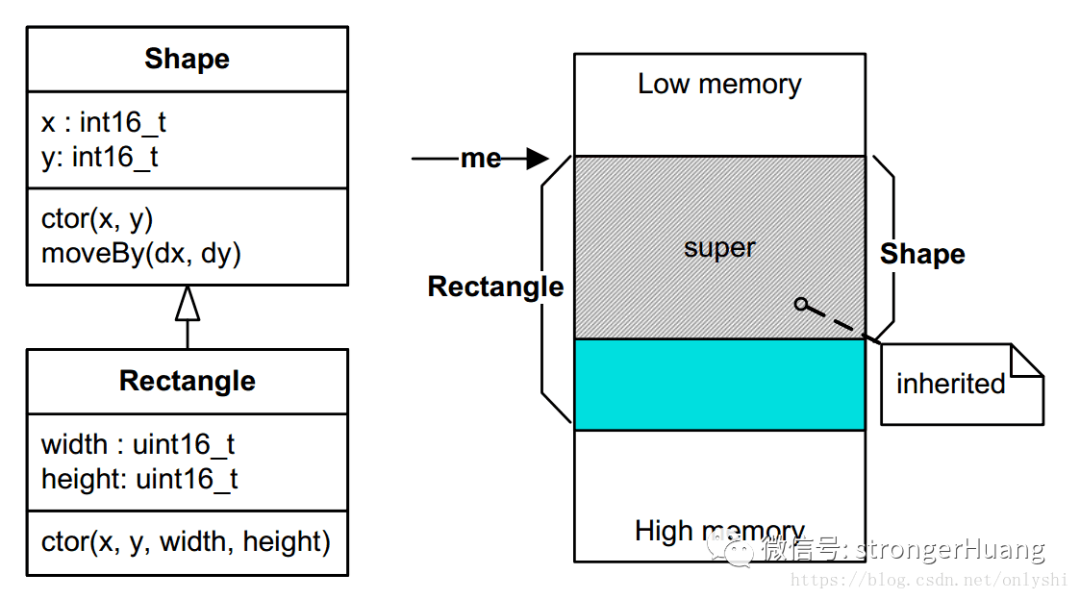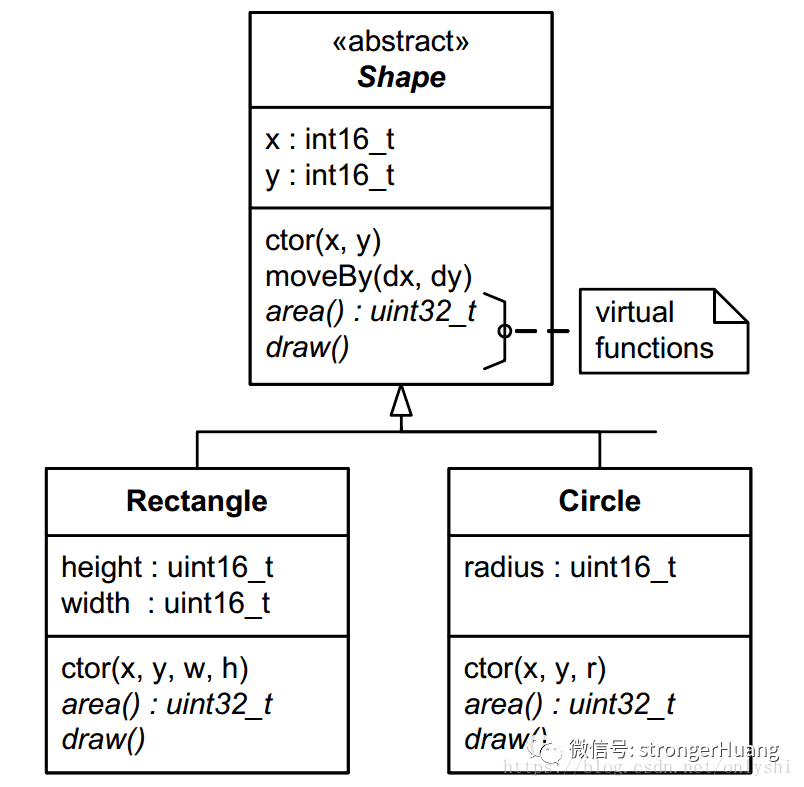不知道有多少人去了解过语言的发展史,早期C语言的语法功能其实比较简单。随着应用需求和场景的变化,C语言的语法功能在不断升级变化。
虽然我们的教材有这么一个结论:C语言是面向过程的语言,C++是面向对象的编程语言,但面向对象的概念是在C语言阶段就有了,而且应用到了很多地方,比如某些操作系统内核、通信协议等。
面向对象编程,也就是大家说的OOP(Object Oriented Programming)并不是一种特定的语言或者工具,它只是一种设计方法、设计思想,它表现出来的三个最基本的特性就是封装、继承与多态。
1、为什么用C实现OOP
阅读文本之前肯定有读者会问这样的问题:我们有C++面向对象的语言,为什么还要用C语言实现面向对象呢?
C语言这种非面向对象的语言,同样也可以使用面向对象的思路来编写程序的。只是用面向对象的C++语言来实现面向对象编程会更简单一些,但是C语言的高效性是其他面向对象编程语言无法比拟的。
当然使用C语言来实现面向对象的开发相对不容易理解,这就是为什么大多数人学过C语言却看不懂Linux内核源码。
所以这个问题其实很好理解,只要有一定C语言编程经验的读者都应该能明白:面向过程的C语言和面向对象的C++语言相比,代码运行效率、代码量都有很大差异。在性能不是很好、资源不是很多的MCU中使用C语言面向对象编程就显得尤为重要。
2、所具备的条件
要想使用C语言实现面向对象,首先需要具备一些基础知识。比如:(C语言中的)结构体、函数、指针,以及函数指针等,(C++中的)基类、派生、多态、继承等。
首先,不仅仅是了解这些基础知识,而是有一定的编程经验,因为上面说了“面向对象是一种设计方法、设计思想”,如果只是停留在字面意思的理解,没有这种设计思想肯定不行。
因此,不建议初学者使用C语言实现面向对象,特别是在真正项目中。建议把基本功练好,再使用。
利用C语言实现面向对象的方法很多,下面就来描述最基本的封装、继承和多态。
3、封装
封装就是把数据和函数打包到一个类里面,其实大部分C语言编程者都已近接触过了。
C 标准库中的 fopen(), fclose(), fread(), fwrite()等函数的操作对象就是 FILE。数据内容就是 FILE,数据的读写操作就是 fread()、fwrite(),fopen() 类比于构造函数,fclose() 就是析构函数。
这个看起来似乎很好理解,那下面我们实现一下基本的封装特性。
#ifndefSHAPE_H
#defineSHAPE_H
#include
//Shape的属性
typedefstruct{
int16_tx;
int16_ty;
}Shape;
//Shape的操作函数,接口函数
voidShape_ctor(Shape*constme,int16_tx,int16_ty);
voidShape_moveBy(Shape*constme,int16_tdx,int16_tdy);
int16_tShape_getX(Shapeconst*constme);
int16_tShape_getY(Shapeconst*constme);
#endif/*SHAPE_H*/
这是 Shape 类的声明,非常简单,很好理解。一般会把声明放到头文件里面 “Shape.h”。来看下 Shape 类相关的定义,当然是在 “Shape.c” 里面。
#include"shape.h"
//构造函数
voidShape_ctor(Shape*constme,int16_tx,int16_ty)
{
me->x=x;
me->y=y;
}
voidShape_moveBy(Shape*constme,int16_tdx,int16_tdy)
{
me->x+=dx;
me->y+=dy;
}
//获取属性值函数
int16_tShape_getX(Shapeconst*constme)
{
returnme->x;
}
int16_tShape_getY(Shapeconst*constme)
{
returnme->y;
}
再看下 main.c
#include"shape.h"/*Shapeclassinterface*/ #include/*forprintf()*/ intmain() { Shapes1,s2;/*multipleinstancesofShape*/ Shape_ctor(&s1,0,1); Shape_ctor(&s2,-1,2); printf("Shapes1(x=%d,y=%d)n",Shape_getX(&s1),Shape_getY(&s1)); printf("Shapes2(x=%d,y=%d)n",Shape_getX(&s2),Shape_getY(&s2)); Shape_moveBy(&s1,2,-4); Shape_moveBy(&s2,1,-2); printf("Shapes1(x=%d,y=%d)n",Shape_getX(&s1),Shape_getY(&s1)); printf("Shapes2(x=%d,y=%d)n",Shape_getX(&s2),Shape_getY(&s2)); return0; }
编译之后,看看执行结果:
Shapes1(x=0,y=1) Shapes2(x=-1,y=2) Shapes1(x=2,y=-3) Shapes2(x=0,y=0)
整个例子,非常简单,非常好理解。以后写代码时候,要多去想想标准库的文件IO操作,这样也有意识的去培养面向对象编程的思维。
4、继承
继承就是基于现有的一个类去定义一个新类,这样有助于重用代码,更好的组织代码。在 C 语言里面,去实现单继承也非常简单,只要把基类放到继承类的第一个数据成员的位置就行了。 例如,我们现在要创建一个 Rectangle 类,我们只要继承 Shape 类已经存在的属性和操作,再添加不同于 Shape 的属性和操作到 Rectangle 中。 下面是 Rectangle 的声明与定义:
#ifndefRECT_H
#defineRECT_H
#include"shape.h"//基类接口
//矩形的属性
typedefstruct{
Shapesuper;//继承Shape
//自己的属性
uint16_twidth;
uint16_theight;
}Rectangle;
//构造函数
voidRectangle_ctor(Rectangle*constme,int16_tx,int16_ty,
uint16_twidth,uint16_theight);
#endif/*RECT_H*/
#include"rect.h"
//构造函数
voidRectangle_ctor(Rectangle*constme,int16_tx,int16_ty,
uint16_twidth,uint16_theight)
{
/*firstcallsuperclass’ctor*/
Shape_ctor(&me->super,x,y);
/*next,youinitializetheattributesaddedbythissubclass...*/
me->width=width;
me->height=height;
}
我们来看一下 Rectangle 的继承关系和内存布局:

因为有这样的内存布局,所以你可以很安全的传一个指向 Rectangle 对象的指针到一个期望传入 Shape 对象的指针的函数中,就是一个函数的参数是 “Shape *”,你可以传入 “Rectangle *”,并且这是非常安全的。这样的话,基类的所有属性和方法都可以被继承类继承!
#include"rect.h"
#include
intmain()
{
Rectangler1,r2;
//实例化对象
Rectangle_ctor(&r1,0,2,10,15);
Rectangle_ctor(&r2,-1,3,5,8);
printf("Rectr1(x=%d,y=%d,width=%d,height=%d)n",
Shape_getX(&r1.super),Shape_getY(&r1.super),
r1.width,r1.height);
printf("Rectr2(x=%d,y=%d,width=%d,height=%d)n",
Shape_getX(&r2.super),Shape_getY(&r2.super),
r2.width,r2.height);
//注意,这里有两种方式,一是强转类型,二是直接使用成员地址
Shape_moveBy((Shape*)&r1,-2,3);
Shape_moveBy(&r2.super,2,-1);
printf("Rectr1(x=%d,y=%d,width=%d,height=%d)n",
Shape_getX(&r1.super),Shape_getY(&r1.super),
r1.width,r1.height);
printf("Rectr2(x=%d,y=%d,width=%d,height=%d)n",
Shape_getX(&r2.super),Shape_getY(&r2.super),
r2.width,r2.height);
return0;
}
输出结果:
Rectr1(x=0,y=2,width=10,height=15) Rectr2(x=-1,y=3,width=5,height=8) Rectr1(x=-2,y=5,width=10,height=15) Rectr2(x=1,y=2,width=5,height=8)
5、多态
C++ 语言实现多态就是使用虚函数。在 C 语言里面,也可以实现多态。 现在,我们又要增加一个圆形,并且在 Shape 要扩展功能,我们要增加 area() 和 draw() 函数。但是 Shape 相当于抽象类,不知道怎么去计算自己的面积,更不知道怎么去画出来自己。而且,矩形和圆形的面积计算方式和几何图像也是不一样的。 下面让我们重新声明一下 Shape 类:
#ifndefSHAPE_H
#defineSHAPE_H
#include
structShapeVtbl;
//Shape的属性
typedefstruct{
structShapeVtblconst*vptr;
int16_tx;
int16_ty;
}Shape;
//Shape的虚表
structShapeVtbl{
uint32_t(*area)(Shapeconst*constme);
void(*draw)(Shapeconst*constme);
};
//Shape的操作函数,接口函数
voidShape_ctor(Shape*constme,int16_tx,int16_ty);
voidShape_moveBy(Shape*constme,int16_tdx,int16_tdy);
int16_tShape_getX(Shapeconst*constme);
int16_tShape_getY(Shapeconst*constme);
staticinlineuint32_tShape_area(Shapeconst*constme)
{
return(*me->vptr->area)(me);
}
staticinlinevoidShape_draw(Shapeconst*constme)
{
(*me->vptr->draw)(me);
}
Shapeconst*largestShape(Shapeconst*shapes[],uint32_tnShapes);
voiddrawAllShapes(Shapeconst*shapes[],uint32_tnShapes);
#endif/*SHAPE_H*/
看下加上虚函数之后的类关系图:

5.1 虚表和虚指针
虚表(Virtual Table)是这个类所有虚函数的函数指针的集合。
虚指针(Virtual Pointer)是一个指向虚表的指针。这个虚指针必须存在于每个对象实例中,会被所有子类继承。
在《Inside The C++ Object Model》的第一章内容中,有这些介绍。
5.2 在构造函数中设置vptr
在每一个对象实例中,vptr 必须被初始化指向其 vtbl。最好的初始化位置就是在类的构造函数中。事实上,在构造函数中,C++ 编译器隐式的创建了一个初始化的vptr。在 C 语言里面, 我们必须显示的初始化vptr。
下面就展示一下,在 Shape 的构造函数里面,如何去初始化这个 vptr。
#include"shape.h" #include//Shape的虚函数 staticuint32_tShape_area_(Shapeconst*constme); staticvoidShape_draw_(Shapeconst*constme); //构造函数 voidShape_ctor(Shape*constme,int16_tx,int16_ty) { //Shape类的虚表 staticstructShapeVtblconstvtbl= { &Shape_area_, &Shape_draw_ }; me->vptr=&vtbl; me->x=x; me->y=y; } voidShape_moveBy(Shape*constme,int16_tdx,int16_tdy) { me->x+=dx; me->y+=dy; } int16_tShape_getX(Shapeconst*constme) { returnme->x; } int16_tShape_getY(Shapeconst*constme) { returnme->y; } //Shape类的虚函数实现 staticuint32_tShape_area_(Shapeconst*constme) { assert(0);//类似纯虚函数 return0U;//避免警告 } staticvoidShape_draw_(Shapeconst*constme) { assert(0);//纯虚函数不能被调用 } Shapeconst*largestShape(Shapeconst*shapes[],uint32_tnShapes) { Shapeconst*s=(Shape*)0; uint32_tmax=0U; uint32_ti; for(i=0U;i< nShapes; ++i) { uint32_t area = Shape_area(shapes[i]);// 虚函数调用 if (area >max) { max=area; s=shapes[i]; } } returns; } voiddrawAllShapes(Shapeconst*shapes[],uint32_tnShapes) { uint32_ti; for(i=0U;i< nShapes; ++i) { Shape_draw(shapes[i]); // 虚函数调用 } }
5.3 继承 vtbl 和 重载 vptr
上面已经提到过,基类包含 vptr,子类会自动继承。但是,vptr 需要被子类的虚表重新赋值。并且,这也必须发生在子类的构造函数中。下面是 Rectangle 的构造函数。
#include"rect.h"
#include
//Rectangle虚函数
staticuint32_tRectangle_area_(Shapeconst*constme);
staticvoidRectangle_draw_(Shapeconst*constme);
//构造函数
voidRectangle_ctor(Rectangle*constme,int16_tx,int16_ty,
uint16_twidth,uint16_theight)
{
staticstructShapeVtblconstvtbl=
{
&Rectangle_area_,
&Rectangle_draw_
};
Shape_ctor(&me->super,x,y);//调用基类的构造函数
me->super.vptr=&vtbl;//重载vptr
me->width=width;
me->height=height;
}
//Rectangle's虚函数实现
staticuint32_tRectangle_area_(Shapeconst*constme)
{
Rectangleconst*constme_=(Rectangleconst*)me;//显示的转换
return(uint32_t)me_->width*(uint32_t)me_->height;
}
staticvoidRectangle_draw_(Shapeconst*constme)
{
Rectangleconst*constme_=(Rectangleconst*)me;//显示的转换
printf("Rectangle_draw_(x=%d,y=%d,width=%d,height=%d)n",
Shape_getX(me),Shape_getY(me),me_->width,me_->height);
}
5.4 虚函数调用
有了前面虚表(Virtual Tables)和虚指针(Virtual Pointers)的基础实现,虚拟调用(后期绑定)就可以用下面代码实现了。
uint32_tShape_area(Shapeconst*constme)
{
return(*me->vptr->area)(me);
}
这个函数可以放到.c文件里面,但是会带来一个缺点就是每个虚拟调用都有额外的调用开销。为了避免这个缺点,如果编译器支持内联函数(C99)。我们可以把定义放到头文件里面,类似下面:
staticinlineuint32_tShape_area(Shapeconst*constme)
{
return(*me->vptr->area)(me);
}
如果是老一点的编译器(C89),我们可以用宏函数来实现,类似下面这样:
#defineShape_area(me_)((*(me_)->vptr->area)((me_)))
看一下例子中的调用机制:
 5.5 main.c
5.5 main.c
#include"rect.h"
#include"circle.h"
#include
intmain()
{
Rectangler1,r2;
Circlec1,c2;
Shapeconst*shapes[]=
{
&c1.super,
&r2.super,
&c2.super,
&r1.super
};
Shapeconst*s;
//实例化矩形对象
Rectangle_ctor(&r1,0,2,10,15);
Rectangle_ctor(&r2,-1,3,5,8);
//实例化圆形对象
Circle_ctor(&c1,1,-2,12);
Circle_ctor(&c2,1,-3,6);
s=largestShape(shapes,sizeof(shapes)/sizeof(shapes[0]));
printf("largetsShapes(x=%d,y=%d)n",Shape_getX(s),Shape_getY(s));
drawAllShapes(shapes,sizeof(shapes)/sizeof(shapes[0]));
return0;
}
输出结果:
largetsShapes(x=1,y=-2) Circle_draw_(x=1,y=-2,rad=12) Rectangle_draw_(x=-1,y=3,width=5,height=8) Circle_draw_(x=1,y=-3,rad=6) Rectangle_draw_(x=0,y=2,width=10,height=15)
6、总结
还是那句话,面向对象编程是一种方法,并不局限于某一种编程语言。用 C 语言实现封装、单继承,理解和实现起来比较简单,多态反而会稍微复杂一点,如果打算广泛的使用多态,还是推荐转到 C++ 语言上,毕竟这层复杂性被这个语言给封装了,你只需要简单的使用就行了。但并不代表,C 语言实现不了多态这个特性。 文章来源:直接来源,嵌入式情报局
-- End--
本号对所有原创、转载文章的陈述与观点均保持中立,推送文章仅供读者学习和交流。文章、图片等版权归原作者享有,如有侵权,联系删除。
审核编辑黄宇
-
封装
+关注
关注
126文章
7881浏览量
142903 -
C语言
+关注
关注
180文章
7604浏览量
136713 -
继承
+关注
关注
0文章
10浏览量
2698
发布评论请先 登录
相关推荐




 C语言实现面向对象三大特性 : 封装、继承、多态
C语言实现面向对象三大特性 : 封装、继承、多态













评论